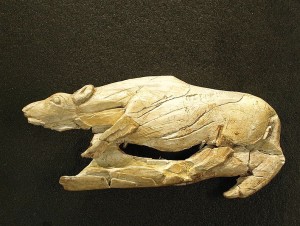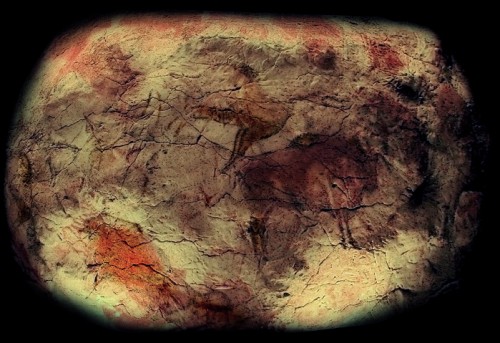When the British Museum puts together an exhibition of more than 100 pieces of prehistoric art from all over Europe, stretching back nearly 40,000 years, you want to go. And so I did, making the rounds of this spectacular show the day after its opening on February 7. You’ve got until May 26 to see it yourself, and it’s as good an excuse as any to visit London and maybe even catch a glimpse of William and Kate while you’re there.
But I had mixed feelings about the exhibition, not least because of its title: “Ice Age art: Arrival of the modern mind.” What does this mean? Was the human mind already modern on its arrival in Europe, or did it only get modern after its arrival on the continent, borne by anatomically modern Homo sapiens immigrating from Africa? Indeed, the title immediately evoked what most human origins researchers today would consider a retrograde, Eurocentric view of human evolution.
 I’ll get to that in a moment. Let’s start off positive: There are some wonderful objects in the exhibition, many of which I, as an archaeology and anthropology reporter, have only written about and never before seen. What a thrill to lay eyes on the Lion Man, a nearly 40,000 year old ivory sculpture found in a cave in Germany during the 1930s, with the head of a lion and the body of a human. It certainly took a modern mind to produce this object, which required imagining a creature that has never actually existed. A well-produced video below the sculpture demonstrates how the artist must have visualized the Lion Man inside the mammoth tusk from which it was carved, using a groove in the tusk as the starting point for its legs.
I’ll get to that in a moment. Let’s start off positive: There are some wonderful objects in the exhibition, many of which I, as an archaeology and anthropology reporter, have only written about and never before seen. What a thrill to lay eyes on the Lion Man, a nearly 40,000 year old ivory sculpture found in a cave in Germany during the 1930s, with the head of a lion and the body of a human. It certainly took a modern mind to produce this object, which required imagining a creature that has never actually existed. A well-produced video below the sculpture demonstrates how the artist must have visualized the Lion Man inside the mammoth tusk from which it was carved, using a groove in the tusk as the starting point for its legs.
Then there was a 32,000 year old flute, made from the wing bone of a Griffon vulture, also found in Germany, one of the earliest known musical instruments. As I walked slowly through the exhibit, knowing that I might never see many of these wonderful objects again, the artworks—carvings of horses heads, bison, and plump ladies with big breasts, early examples of what I call the highly influential Naked Lady School of Art—got progressively younger, although not necessarily more sophisticated.
And that brings me to the troubling aspect of the exhibit. For the last 10 years, as an anthropology reporter for Science, I have written one article after another telling readers that the whole idea of “modernity” is increasingly embarrassing to human evolution researchers. The earliest fossils of our species, from Omo Kibish in Ethiopia, are nearly 200,000 years old, which means that we have been anatomically modern at least that long. So when we make the admittedly spectacular artworks of the European Upper Paleolithic, which began about 40,000 years ago, the bellwether of modern human cognition, we are implying that the earlier H. sapiens who lived in Africa weren’t fully modern. Is it more than just one more step to say that they were primitive, thus conjuring up lots of old stereotypes? Indeed, a few researchers, including archaeologist Richard Klein at Stanford University, have argued that some sort of genetic mutation occurred about 50,000 years ago that accounts for this supposed Upper Paleolithic revolution—but that idea is now rejected by the overwhelming majority of experts.
 Consistent with this new approach, archaeologists working in Africa are now routinely coming up with evidence of sophisticated cognition at much earlier sites, such as Blombos in South Africa, where etched ochre possibly representing early artworks have now been dated to 100,000 years ago; the clock for such behaviors continues to be set back by new discoveries.
Consistent with this new approach, archaeologists working in Africa are now routinely coming up with evidence of sophisticated cognition at much earlier sites, such as Blombos in South Africa, where etched ochre possibly representing early artworks have now been dated to 100,000 years ago; the clock for such behaviors continues to be set back by new discoveries.
Earlier this month in Science, I profiled Stony Brook University archaeologist John Shea, who argues that researchers should throw out the whole idea of “behavioral modernity” entirely, on the grounds that we have been modern since the beginning of our species 200,000 years ago– so there is no use in trying to identify some rubicon of modernity that we passed later. Shea laid this all out in a 2011 article in Current Anthropology entitled “Homo sapiens is as Homo sapiens Was.”
So, if Shea is right—and I quoted a number of scientists who agreed with him in whole or in part—then the artists whose works are featured at the British Museum were simply part of a tradition already well under way. The modern mind had arrived long, long before, it just took us until very recently to realize it.
Michael Balter is a contributing correspondent at Science and an adjunct professor of journalism at New York University.
Photos: REplica of art from Altamira Cave, courtesy José-Manuel Benito; Atlatl carved in shape of creeping hyena from La Madelaine rockshelter, courtesy Wikimedia Commons; etched ochre from Blombos Cave, courtesy C. Hensilwood and Wikimedia Commons.

Huh, I read the exhibition title as relating to the arrival of anatomically modern humans in *Europe*, given that as far as I am aware this occurred ~40k years ago – around the same time as their oldest specimens.
Having said that, I think you can’t judge anything on its title alone and it depends how the rest of the exhibition is framed. I’ll have to go see!
Recent art trends journalism and pop culture tv seem to reinforce this definition of modern human behavior you describe. My initial reaction to these repetitions is similar, especially if there is no further discussion, or even posing the question of modernity. Sounds as if the exhibition didn’t explore this; so despite the thorough acquisition of exciting visuals, the intellectual context is pointedly thin. Now I’m curious why.